During the regular season, it’s fairly easy to determine the relative strength of different teams’ rotations. Just about every team is on even ground in using five starters (though some use six these days) to grind through the 162-game schedule, so statistics can often tell most of the story.
It’s far more complicated, though, to discern which team has the starting pitching advantage during the postseason, especially with the new 12-team format. In the best-of-three wild-card series, teams may end up using only two starters, so front-end dominance could play a greater role in the playoffs moving forward. That said, because of the additional round—and especially this year, with the lockout forcing there to be fewer off days during the postseason—starting pitching depth will be even more important.
To put together my rankings, I prioritized strength atop the rotation, because one or two aces peaking at the right time could be all it takes for a team to advance through the first couple of rounds. That means, for the most part, I emphasized strikeout stuff and fielding-independent pitching over ERA and soft contact. From there, if teams featured similar Nos. 1 and 2 starters, I gave the edge to the ones with greater rotational depth.
I’m going to make what may be a controversial move and exclude the Orioles, who are 3.5 games behind the Mariners for the final wild-card spot with eight to play. That’s certainly not an insurmountable deficit, but Seattle’s remaining schedule is softer than chinchilla fur, and Baltimore ultimately seems destined to end up as this year’s version of the 2021 Mariners—a young, plucky group a year ahead of schedule. Orioles fans can take comfort in knowing that if the O’s were included here, the Jordan Lyles–led unit would rank last, anyway.
13. Cleveland Guardians
Projected rotation: Shane Bieber, Triston McKenzie, Cal Quantrill, Aaron Civale
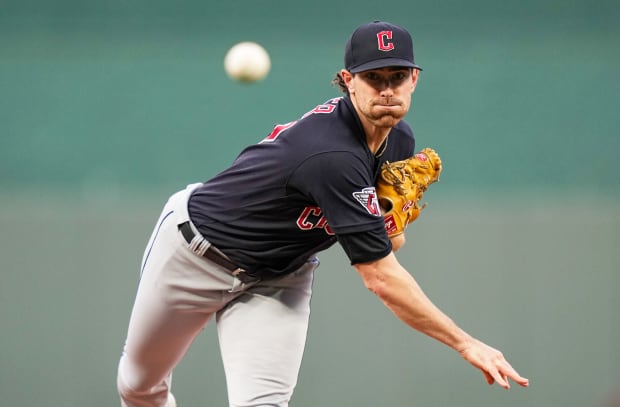
Jay Biggerstaff/USA TODAY Sports
Even though this is the youngest four-man group on this list, Cleveland would rank higher if we were making this exact comparison two years ago. While Bieber’s control has never been better, his once MLB-leading strikeout rates have become rather pedestrian. That combination has helped the 2020 American League Cy Young winner lead the AL in innings, but it also opens the door for another batted-ball disaster in the playoffs, as he experienced in Game 1 of the wild-card round against the Yankees two years ago (when MLB first experimented with an expanded playoff format during the COVID-19-shortened season). McKenzie and Quantrill have likewise seen their strikeout rates regress to career-worst levels this year, while only Blue Jays righty José Berríos (5.37) owns a worse ERA than Civale’s 5.19 mark among MLB projected postseason starters.
The entire rotation’s 4.03 FIP (17th in MLB) and 92.4-mph average fastball velocity (28th in MLB) both rank last among playoff teams, underscoring the low likelihood of the rotation carrying Cleveland to playoff success. Thankfully for the Guardians, they boast an excellent defense that should be able to convert more balls in play into outs than most of their peers would. That’s not what we’re ranking here, though.
12. Tampa Bay Rays
Projected rotation: Shane McClanahan, Corey Kluber, Drew Rasmussen, Jeffrey Springs, Tyler Glasnow*
*Returning from injury.
The Rays have become known for their starter shenanigans over the years, but they’ve operated with the above four starters for most of the season, so their postseason plan should be pretty straightforward. Tampa Bay’s starters ranks third in rotation ERA (3.47) and boast the lowest walk rate (5.7%) in the league, but they’ve also thrown the fewest innings of any MLB starting unit by a wide margin—and nearly 100 fewer than the next closest potential playoff team. McClanahan has also not been the same since the All-Star Game, and the one-time AL Cy Young favorite now might be the weakest No. 1 starter in the field.
That said, every Rays projected starter except Kluber has an ERA below 3.00. They acquired Rasmussen as a bullpen arm from Milwaukee last year, harnessed his wild tendencies and turned him into a solid starter. Springs was likewise converted into a starter after Tampa Bay added him from Boston last year. Both of them will be on a short leash, though—the pair of former relievers completed at least six innings 15 times in 50 regular-season starts and will likely be asked to throw no more than five in October. The expected return of Glasnow on Wednesday from Tommy John surgery provides a tantalizing dimension to the pitching staff, but with him having been used in bursts of less than 50 pitches during his recent rehab starts, it seems likely Tampa Bay won’t use Glasnow in a traditional starter’s role in an effort to protect the injury-plagued pitcher.
Watch MLB games live with fuboTV: Start a free trial today!
11. St. Louis Cardinals
Projected rotation: Adam Wainwright, Miles Mikolas, José Quintana, Jordan Montgomery, Jack Flaherty*
*Returning from injury.
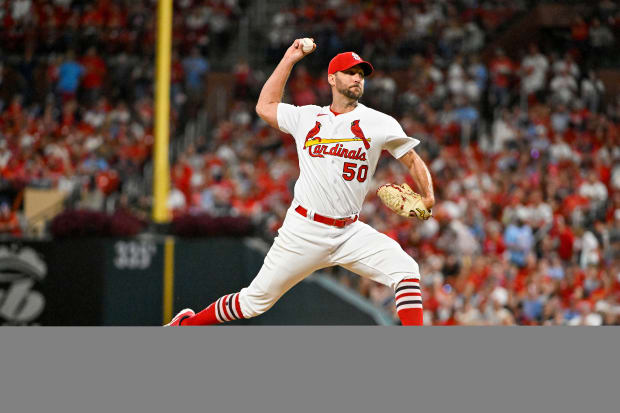
Jeff Curry/USA TODAY Sports
Among the 13 potential playoff teams, St. Louis’s starting pitching ranks last in a lot of categories, including fWAR (9.7, 17th in MLB), xFIP (4.08, 17th) and strikeout rate (18.4%, 24th). But this rotation also improved more than anyone else’s at the trade deadline with the acquisitions of Quintana and Montgomery, who have both excelled with the Cardinals and boosted their rotation to the seventh-best fWAR total in the second half (sixth among playoff teams). They’re also the second-best unit in the league at keeping the ball in the park (behind only the Giants).
The 33-year-old Quintana has been this team’s best pitcher since coming over from Pittsburgh, allowing just one home run in 54⅔ innings en route to a 2.13 ERA. He actually leads all Cardinals starters with 3.7 fWAR this year, but you wonder how long his crafty method of inducing soft contact will hold up. Wainwright, meanwhile, has not looked like himself in September, as he’s dealt with some fatigue and mechanical issues. This is another soft-tossing staff, as no projected playoff starter has an average fastball velocity above Mikolas’s 93.6-mph heater. Flaherty could still factor in here, but it’s hard to count on him after his multiple injuries over the last year and a half. He was sharp in his most recent outing last week at San Diego. He went six innings, allowed three runs, struck out nine and threw 99 pitches, a sign that he could be close to full strength after returning from his second IL stint of the season.
10. Toronto Blue Jays
Projected rotation: Kevin Gausman, Alek Manoah, Ross Stripling, José Berríos
I initially had this group ranked higher based on the strength of Gausman and Manoah—no top two pitchers among potential playoff teams have more combined fWAR (9.8). Gausman leads all AL pitchers in several key peripheral stats such as fWAR (5.6), FIP (2.42) and K/BB ratio (7.2), while Manoah has better surface-level results by ranking third in innings (190⅔) and ERA (2.31).
The uncertainty at the back end led me to downgrade the Jays a bit, however. Some would say they should be even lower, as their 4.04 rotation ERA ranks last among potential playoff teams. But that figure has been dragged down by the struggles of Berríos, Yusei Kikuchi and Mitch White, of which only one should start for Toronto in October. Berríos, who has playoff experience from his time in Minnesota, seems like the most likely choice despite carrying the second-worst ERA (5.60) since the All-Star break among 63 qualified starters.
9. Milwaukee Brewers
Projected rotation: Corbin Burnes, Brandon Woodruff, Eric Lauer, Freddy Peralta
The Brewers’ rotation has been far from a disaster, but it also hasn’t matched the exploits of last year’s three-headed monster of Burnes, Woodruff and Peralta. Not a single starter possesses an ERA under 3.00 after all three of those guys did in 2021. Burnes, the reigning NL Cy Young winner, still leads the NL with 231 strikeouts, but his FIP has almost exactly doubled from 1.63 in ’21 to 3.27 in ’22. Part of the issue across the board has been an increase in handing out free passes, as the Brewers have the worst walk rate among potential playoff teams (8.6%, 25th in majors).
Right now, Milwaukee sits 1.5 games behind the Phillies for the final NL wild card, so this could be the one rotation ranked here that doesn’t pitch in the postseason. Also working against the Brewers is that both Lauer and Peralta recently returned from the injured list in a span of three days, and manager Craig Counsell recently said Peralta could be liberally used out of the bullpen as he builds his pitch count back up, instead of as a starter. Still, if Milwaukee does sneak in, this unit certainly has the potential to serve as the engine for some series wins.
8. New York Yankees
Projected rotation: Gerrit Cole, Nestor Cortes Jr., Luis Severino, Jameson Taillon
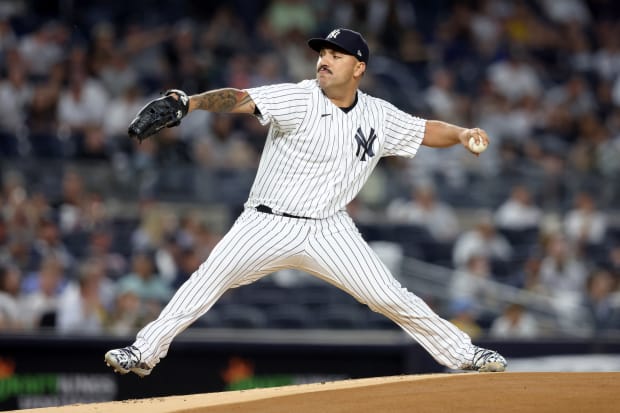
Brad Penner/USA TODAY Sports
The Yankees live and die by home runs. They own the second-best home run differential in the majors (+90), behind only the Braves (+92). And yet, its rotation has recorded the worst home run rate (1.23 HR/9) among the 13 potential playoff teams. (The bullpen, meanwhile, has allowed the fewest HR/9 in the majors.) The Yankees’ worst offender is ace Gerrit Cole, who has served up an AL-high 31 homers, including 14 since the All-Star break, the most among qualified starters. Even so, he leads the majors with 244 strikeouts and has a solid 3.49 ERA. Moreover, his 2.93 ERA in 14 postseason starts indicates he’s been quite underrated for his performances in October.
The biggest wrench in New York’s postseason plans has been the failed acquisition of Frankie Montas. Oakland’s former ace posted a 6.35 ERA in eight starts with the Yankees before succumbing to shoulder pain that manager Aaron Boone has confirmed will keep Montas out of the postseason rotation, if not off the roster altogether. Still, the continued breakout of Cortes (rotation-best 2.56 ERA) and Taillon helped New York win just its second AL East crown in the past 10 years. Luis Severino has been sharp in his two starts since returning from the IL, striking out 10 and allowing three runs (all earned thanks to some questionable official scoring in Toronto). Most importantly, his fastball velocity averaged 97.3 mph in his second outing since returning, up 1.1 from his season average, and he has not given up a home run. He’s on track to carry a full workload by the time the postseason begins, making him one of the nastiest third or fourth starters—depending on where the Yankees slot him—in the playoffs.
7. Philadelphia Phillies
Projected rotation: Aaron Nola, Zack Wheeler, Ranger Suárez, Kyle Gibson
The Phillies are sort of like the NL version of the Blue Jays, except with stronger options at every spot. But there are similarities between the two in that they both have two studs at the top, a decent No. 3 starter in Suárez and a big question mark after that. Philly’s 16.6 rotation fWAR and 5.9% walk rate both lead the NL and rank second overall, but thanks to a shoddy defense they rank just 13th in the majors with a 3.82 rotation ERA.
Nola’s 5.8 fWAR ranks second overall behind only San Francisco’s Carlos Rodón. That gives him an argument as the best pitcher in the playoffs. The aforementioned fielding issues have made his surface stats such as ERA (3.28) seem not quite as impressive, though. Wheeler’s return from the injured list last week after a monthlong stay due to forearm inflammation could act as the spark that snaps the franchise’s 11-year playoff drought. He’s looked like the same guy who finished as the NL Cy Young runner-up when he’s been out there. Gibson is in the middle of his second second-half meltdown in as many seasons in Philadelphia, but interim manager Rob Thomson doesn’t really have a better No. 4 option since Zach Eflin has only recovered enough from a knee injury that landed him on the 60-day IL to pitch in relief.
6. San Diego Padres
Projected rotation: Yu Darvish, Blake Snell, Joe Musgrove, Mike Clevinger
The top three Padres starters are as good as you’ll find in the league, especially since Snell has come on strong in the second half. But they are another team with a potential black hole at the No. 4 spot given the struggles of Clevinger, whose 5.91 FIP since the All-Star break ranks last among 65 qualified starters, and Sean Manaea, who’s been even worse with an unsightly second-half 7.61 ERA. Those two have dragged down the rotation into posting the second-worst ERA (4.09) among potential playoff teams since the break.
Nick Martinez (3.58 ERA in 43 games, 10 starts) could be the answer, but he’s been better as a reliever, and manager Bob Melvin previously committed to keeping him in the bullpen after shuttling him back and forth between roles this year. If the Friars shake off last season’s demons and finish strong, it may come down to which of Clevinger and Manaea has the better final outing.
Watch baseball all season long with fuboTV. Start your free trial today.
5. Los Angeles Dodgers
Projected rotation: Julio Urías, Clayton Kershaw, Tyler Anderson, Andrew Heaney
This is probably a few spots lower than many people would put the Dodgers, given that their 2.75 rotation ERA is the best in the majors, as is their 1.04 WHIP. Urías may have emerged as the Game 1 starter in Chavez Ravine after recording MLB’s second-best ERA (1.34) among qualified starters in the second half, and Kershaw remains one of the game’s filthiest pitchers. But this depleted unit has quite a few causes for concern.
First, there are the team’s many injuries. Walker Buehler is out for the season after having Tommy John surgery last month. Dustin May went on the injured list Saturday with lower back tightness, so it’s hard to say if Los Angeles can rely on him. And while Tony Gonsolin is on track to return soon from his forearm strain, which has kept him out since late August, he almost certainly won’t be fully stretched out by the time the playoffs begin after throwing just two innings in his last rehab start. That leaves four lefties projected to start for the Dodgers in the playoffs, and they seem likely to run into a team that mashes southpaws like the Cardinals (first in MLB with a 131 wRC+ against LHP), Braves (118 wRC+, fifth) or Phillies (115 wRC+, sixth). They could choose to use a right-handed opener over Heaney—Gonsolin would be the most logical choice—but they still would need to cover a lot of innings with a bulk guy, who might end up being Heaney, anyway.
Furthermore, the team’s league-best .251 opponents’ BABIP indicates every L.A. pitcher has benefited from some stellar defense. Two other question marks are Anderson and Heaney, who are having career-best years out of nowhere. Anderson has been awesome since signing a one-year, $8 million deal in the offseason; he delivered a breakout All-Star campaign after being thrust into the rotation due to injuries. Heaney has had multiple lengthy IL stints, and he’s struggled mightily over his last eight starts (4.91 ERA, 5.25 FIP).
Despite these worries, though, Dodgers fans can take solace in knowing that real games are about more than just isolating the dominance of a club’s pitching staff. The defense behind the pitchers matters, too, and in that area L.A. excels.
4. Atlanta Braves
Projected rotation: Max Fried, Spencer Strider, Kyle Wright, Charlie Morton
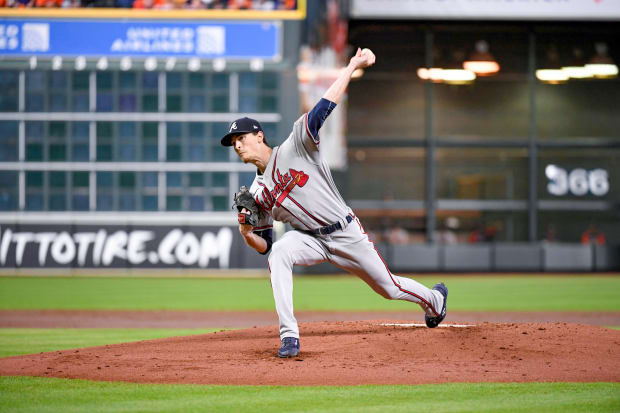
Greg Nelson/Sports Illustrated
Atlanta’s ranking depends heavily on the health of Spencer Strider, the rookie sensation who went on the injured list last week with a sore oblique. This ranking is operating under the (perhaps foolish) assumption that Strider can recover and resume his dominant form—the gap between Strider and the second-place pitcher in strikeout rate (min. 100 IP) is larger than the gap between second place and 16th place.
This isn’t all Strider’s show, though. This team won the World Series last year, after all, with Max Fried emerging as a bona fide ace and the projected No. 3 starter in Wright currently counting as MLB’s only 20-game winner. Atlanta’s rotation ranks second overall in strikeout rate (25.2%) and is second-best among playoff teams at keeping the ball in the park despite calling a very hitter-friendly stadium home. The Braves have also logged the highest average fastball velocity (95.1 mph) among potential playoff teams, behind only the Giants among all MLB teams. Still, without Strider, Atlanta would slot in at 9th in these rankings (with the wildly disappointing veteran Jake Odorizzi, a pair of rookies in Bryce Elder and Kyle Muller and a bullpen game ranking among the candidates for the fourth starter spot, with those possibilities being listed in reverse order of likelihood). That’s how dominant the rookie righthander has been.
3. Seattle Mariners
Projected rotation: Robbie Ray, Luis Castillo, Logan Gilbert, George Kirby
The Mariners are ranked higher than most statistics would dictate because of their tremendous depth and potential (and the fact that Castillo and Kirby haven’t been with the club all season, which throws off the metrics). This may be the league’s best top-to-bottom playoff rotation, with all four projected playoff starters boasting ERAs in the mid-threes.
Ray is the reigning AL Cy Young winner. Castillo is the newly acquired and extended midseason trade pickup. Gilbert is the lone holdover from last year’s upstart squad, a fast maturing righty who ranks in the top 10 of AL pitchers in ERA, FIP, innings and strikeout rate, among other metrics. And Kirby is the rookie with better command than all of them. None of them have quite dealt like an ace all season, which prevents the Mariners from climbing any higher than here. But it wouldn’t be surprising to see them all do so in the postseason. Before that can happen, though, the M’s need to finish off the Orioles and officially snap the streak of futility Seattle has long been waiting to see broken.
2. Houston Astros
Projected rotation: Justin Verlander, Framber Valdez, Lance McCullers Jr., Cristian Javier
The Astros’ wildly successful six-man rotation will surely be cut down to four in October, and it speaks to their depth that they could slot in any of four options (McCullers, Javier, José Urquidy, Luis Garcia) behind Verlander and Valdez and still have the No. 2 staff. Houston’s expanded rotation lets pitchers go deeper into games, which has enabled them to lead all starting units in innings pitched and rotation fWAR by a wide margin. The Astros also rank second in ERA (3.00) and WHIP (1.07).
Houston boasts the best one-two punch by fWAR among potential playoff teams with Verlander and Valdez, who pose a killer contrast in styles. McCullers has made only seven starts this season, but aside from some control issues (4.5 BB/9) has looked solid (2.38 ERA) since returning from a forearm injury, which occurred during last year’s ALDS. And the No. 4 spot will probably go to Javier, whose 1.96 ERA since the All-Star break ranks second in the AL over that span. That’s what you call quality and quantity.
1. New York Mets
Projected rotation: Jacob deGrom, Max Scherzer, Chris Bassitt, Taijuan Walker
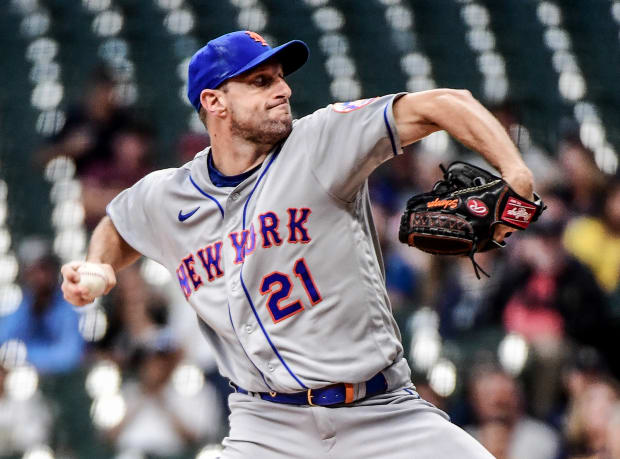
Benny Sieu/USA TODAY Sports
The Mets brought in Scherzer and Bassitt over the offseason to create the most imposing playoff rotation possible. There were a few injuries along the way during the regular season, but New York looks like it’ll be at full strength at the most important time of the year. Its 3.41 FIP and 3.45 xFIP both trail only San Francisco and are the best marks among playoff teams. The Mets also boast MLB’s highest strikeout rate (25.3%).
The only knock against this setup is the No. 4 spot. Walker’s ERA has ballooned from 2.55 in the first half to 5.11 since the All-Star break, and Carlos Carrasco has allowed more than a hit per inning with a slightly below-average 3.95 ERA. The best idea may be to piggyback the righthanders in a hypothetical Game 4. Houston would probably feel good about a Javier, Urquidy or Garcia matchup against Walker or Carrasco in a possible World Series meeting. When it comes down to it, though, deGrom and Scherzer are the best one-two punch in the majors, and Bassitt is really good in his own right. That doesn’t leave much room for error.







